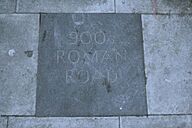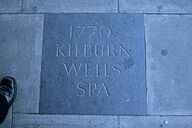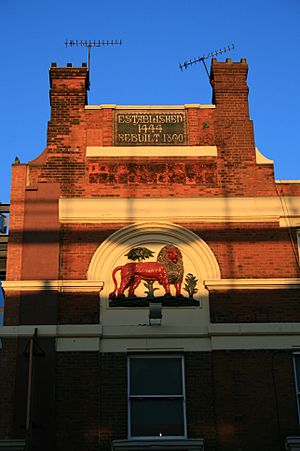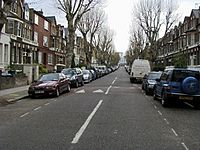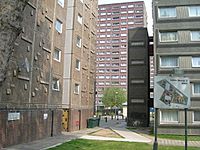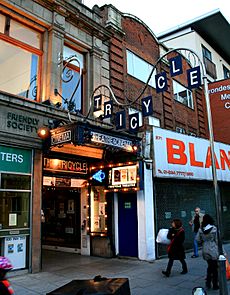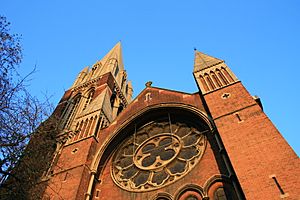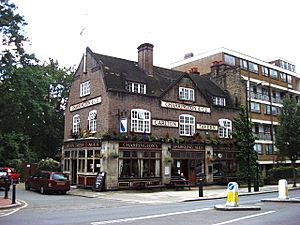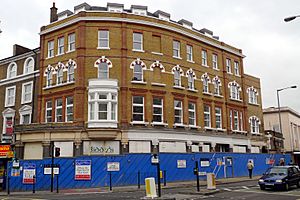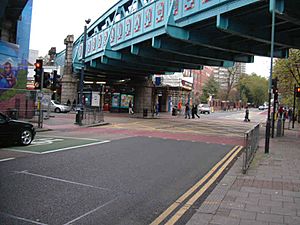Kilburn, London facts for kids
Quick facts for kids Kilburn |
|
|---|---|
 Carlton Vale and The Shamrock public house |
|
| Population | 29,027 (2011 Census Brent and Camden Wards) |
| OS grid reference | TQ245835 |
| London borough | |
| Ceremonial county | Greater London |
| Region | |
| Country | England |
| Sovereign state | United Kingdom |
| Post town | LONDON |
| Postcode district | NW6 |
| Dialling code | 020 |
| Police | Metropolitan |
| Fire | London |
| Ambulance | London |
| EU Parliament | London |
| UK Parliament |
|
| London Assembly |
|
Kilburn is a lively area in London. It sits right on the edge of three different London boroughs: Camden, Brent, and the City of Westminster. It's located about 3.5 miles (5.6 km) northwest of Charing Cross, a well-known spot in central London.
Kilburn started as a small village that grew along an ancient road called Watling Street. This old road is now known as the A5 Road. The village got its name from Kilburn Priory, a religious building that was built next to the Kilburn Brook. Today, Watling Street forms the boundary between the boroughs of Brent and Camden.
The area is known for having London's largest Irish community. It also has a big Afro-Caribbean population. A famous civil rights leader named Billy Strachan once lived here.
Contents
What are Kilburn's Boundaries?
Kilburn has never been an official administrative area. This means it doesn't have fixed, formal boundaries. The area got its name from a nearby stream and the priory. It grew as a long, narrow village along Watling Street. This street was the boundary between the old areas of Willesden (now part of Brent) and Hampstead (now part of Camden).
If you think of Kilburn extending into the City of Westminster, it would cover parts of Paddington and Marylebone. These areas became part of Westminster in 1965. There are also electoral areas called 'Kilburn (Camden)' and 'Kilburn (Brent)' that cover parts of the area.
Most of Kilburn is in the NW6 postcode area. However, postcode areas don't define exact districts. Kilburn, like many London areas, overlaps with others. Some of these, like Willesden and Hampstead, have historical boundaries. Others, like Brondesbury, do not.
 |
Willesden Green, Brondesbury | Fortune Green/West Hampstead, Cricklewood | West Hampstead |  |
| Queen's Park, Brondesbury/Kensal Rise | South Hampstead, Swiss Cottage | |||
| West Kilburn, Kensal Town | Maida Hill/Maida Vale | St John's Wood |
Kilburn's Past: A Journey Through Time
Kilburn High Road started as a very old path. It was part of a route connecting ancient British settlements. These are now known as Canterbury and St Albans. When the Romans arrived, they paved this route. During Anglo-Saxon times, it became known as Watling Street.
The Kilburn Priory was built next to a stream. This stream was called Cuneburna, Kelebourne, or Cyebourne. It flowed from Hampstead through Kilburn and then through other parts of London. Today, this stream is known as the River Westbourne. By the 1850s, much of it was put into underground pipes and became one of London's underground rivers.
The name "Kilburn" was first written down in 1134. It referred to the priory, which was built where a hermit named Godwyn had lived. Godwyn had built his hermitage by the Kilburn river around the time of King Henry I (1100-1135). Both his hermitage and the priory were named after the river.
Kilburn Priory: A Stop for Pilgrims
Kilburn Priory was a small group of nuns, likely Augustinian canonesses. It was founded in 1134. The priory was located at the Kilburn river crossing on Watling Street. This is where Kilburn High Road and Belsize Road meet today. Because it was on Watling Street, the priory became a popular resting place for pilgrims. These pilgrims were traveling to religious sites in St Albans and Willesden.
King Henry VIII closed down the priory in 1536–37. Nothing remains of it today. However, the name of Abbey Road (in nearby St John's Wood) comes from a path that once led to the priory. The priory's land included a large house and a guesthouse. This guesthouse might have been the start of the Red Lion pub, which is thought to have opened in 1444. Across the street, the Bell Inn opened around 1600.
Kilburn Wells: A Place for "Medicinal Waters"
In the 1700s, people believed in the healing power of "medicinal waters." In 1714, a well with iron-rich water was found near the Bell Inn in Kilburn. To attract visitors, like the nearby Hampstead Well, gardens and a "great room" were opened. The water was advertised as a cure for "stomach ailments."
The Public Advertiser newspaper wrote on July 17, 1773:
Kilburn Wells, near Paddington.—The waters are now in the utmost perfection; the gardens enlarged and greatly improved; the house and offices re-painted and beautified in the most elegant manner. The whole is now open for the reception of the public, the great room being particularly adapted to the use and amusement of the politest companies. Fit either for music, dancing, or entertainments. This happy spot is equally celebrated for its rural situation, extensive prospects, and the acknowledged efficacy of its waters; is most delightfully situated on the site of the once famous Abbey of Kilburn, on the Edgware Road, at an easy distance, being but a morning's walk, from the metropolis, two miles from Oxford Street; the footway from the Mary-bone across the fields still nearer. A plentiful larder is always provided, together with the best of wines and other liquors. Breakfasting and hot loaves. A printed account of the waters, as drawn up by an eminent physician, is given gratis at the Wells.
In the 1800s, the wells became less popular. However, Kilburn Wells remained a popular tea garden. The original Bell Inn was torn down and rebuilt in 1863. The Kilburn part of Watling Street, now called Edgware Road and Kilburn High Road, slowly filled with inns and farmhouses. Even with the discovery of the well, Kilburn didn't see much building until around 1819. This was near St John's Wood. These 19th-century developments show how the small roadside village of Kilburn grew into the modern area we know today.
Between 1839 and 1856, William Henry Smith, who later became a famous newsagent, lived in Kilburn. Much of the area was developed in the late 1800s by Solomon Barnett. He named many streets after places in the West Country or after popular poets to honor his wife.
Kilburn's Role in Irish History
On June 8, 1974, the funeral of Michael Gaughan took place in Kilburn. He was an Irish republican who died during a hunger strike. Over 3,000 people lined the streets of Kilburn. They marched behind his coffin to a service at the Church of the Sacred Heart of Jesus.
The Biddy Mulligan's pub on High Road was popular with the local Irish community. On December 21, 1975, it was bombed by the Ulster Defence Association (UDA). This was during a period of conflict in Northern Ireland known as The Troubles. Although 90 people were in the pub, few were injured. This was the only bombing by a loyalist group in London during that conflict.
Who Lives in Kilburn?
Kilburn is home to many different ethnic groups. These include people of Irish, Afro-Caribbean, Indian, Bangladeshi, Pakistani, Eritrean, and Ethiopian backgrounds. Since the area is split between several London boroughs, information is gathered from different parts of Kilburn.
About 4.7% of the people in Kilburn were born in Ireland. An even higher percentage are second-generation Irish (born in England but of Irish descent). This gives Kilburn the largest Irish population of any area in London. Irish community events, pubs, and GAA sports clubs are common. Annual St Patrick's Day celebrations are also a big part of the area. The 2007 Irish-language film Kings was filmed in Kilburn. It is based on a play called The Kings of the Kilburn High Road.
In the 2011 census, the Kilburn ward of Brent was 28% White British, 17% White Other, and 12% Black African. The Kilburn ward of Camden was 35% White British and 19% White Other. The Maida Vale ward of Westminster was 38% White British and 22% White Other.
Homes in Kilburn: A Mix of Old and New
Kilburn has a mix of different types of homes. You can find large and expensive Victorian houses. There are also council housing estates, which can sometimes be run-down. This shows that there is a big difference in wealth among the people living in Kilburn.
Famous Places in Kilburn
Kilburn High Road: The Heart of the Area
Kilburn High Road is the main street in Kilburn. It follows part of an old Roman road, which was later called Watling Street. This road was based on an even older Celtic route.
The High Road runs roughly northwest to southeast. It forms the border between the London boroughs of Camden (to the east) and Brent (to the west). It is a section of the Edgware Road (which is part of the A5).
There are two railway stations on Kilburn High Road. These are Brondesbury station (on the London Overground North London Line). About 1.25 km (nearly a mile) further south is Kilburn High Road station (also London Overground). Kilburn Park Underground station, on the Bakerloo line, is just west of the High Road's southern end. Kilburn Underground station is on the northern side of the High Road.
Kilburn Grange Park is a green space located on the east side of Kilburn High Road. The name of Ian Dury's first band, Kilburn and the High Roads, refers to this road. The songs "Kilburn High Road" by Flogging Molly and Shack also mention it.
Gaumont State Cinema: A Grand Old Building
A famous landmark on Kilburn High Road is the Gaumont State Cinema. This building is Grade II* listed, meaning it's very important. It was designed by George Coles and opened in 1937. At the time, it was the biggest auditorium in Europe, with seats for 4,004 people. For 20 years, it was a bingo hall. In 2007, a church bought it.
The Kiln Theatre: A Hub for Arts
The Kiln Theatre is on Kilburn High Road. It opened in 1980 as the Tricycle Theatre in a converted hall. It was renamed The Kiln in April 2018. The Kiln now has a gallery and a cinema, as well as the theatre. It is known for its political plays, including ones about important court cases. One play about the US detention center at Guantánamo Bay, Cuba even moved to the West End and New York City. The Kiln Theatre shows many international plays and films. It also runs social and educational programs for the local community.
Other Interesting Buildings
To the south, the sky in Kilburn is dominated by the tall, Gothic spire of St. Augustine's, Kilburn. This church was finished in 1880. It has a beautiful Victorian interior with carved stone and stained glass. It's sometimes called "the Cathedral of North London" because of its size. When it was built, it was the third-largest place of worship in London.
At 10 Cambridge Avenue, just off Kilburn High Road, is "The Animals WW1 memorial dispensary." This building dates back to the early 1930s. It opened in 1931 and treated over 6,000 animals in its first year. Above the door, there's a large bronze plaque. It's a memorial to animals that died in the First World War. Next door, at 12-14 Cambridge Avenue, is a rare "Tin Tabernacle" from 1863. This unusual building is now used by an arts charity.
Just south of St. Augustine's on Carlton Vale is the rebuilt Carlton Tavern. This pub was built in 1920-21. It was known for its original 1920s interior and tiled exterior. In 2015, it was unexpectedly torn down by a property developer. However, after a community campaign, the pub was rebuilt and reopened.
The Irish pub Biddy Mulligan's was at 205 High Road. It was built in 1862 and was first called The Victoria Tavern. It was renamed in the 1970s after a character from an Irish comedian. The pub was bombed in 1975 by a loyalist group. It later closed down in 2009.
Getting Around Kilburn: Transport Links
Tube and Train Stations
Kilburn High Road has several railway lines that cross it. These lines connect the area to central London and outer northwest London suburbs. The first railways came to Kilburn in 1852. Today, Kilburn is served by London Underground and London Overground from these stations:
- Kilburn Park station (London Underground - Bakerloo line) is in central Kilburn.
- Brondesbury station (London Overground - North London line) is in North Kilburn.
- Kilburn High Road station (London Overground - Watford DC line) is in central Kilburn.
Even though it's called Kilburn tube station, Kilburn tube station is actually in Brondesbury Park, not Kilburn itself.
Bus Routes
Many bus routes serve Kilburn along the High Road. Most of these routes come south from Cricklewood. They connect Kilburn to various places in central and west London.
Kilburn in the Media
The Brent & Kilburn Times and the Camden New Journal provide local news. In the 2017 film, The Only Living Boy in New York, a character says she moved to Kilburn because it felt more real.
Sports in Kilburn
Kilburn is home to several sports clubs:
- Kilburn Cosmos RFC is a rugby club.
- South Kilburn F.C. plays in the Combined Counties League.
- Kilburn is home to Kilburn Gaels GAA Hurling Club.
- Kilburn Football Club plays in the Middlesex County League. They train regularly in Grange Park.
- One of the 12 founding members of the Football Association was formed in Kilburn in 1863. It was called the N.N. Club or N.N. Kilburn. This club provided the first president of the Football Association.
Kilburn's Importance in London
The London Plan identifies Kilburn as one of 35 major centers in Greater London. This means it's an important place for jobs, shops, and services in the city.
Famous People from Kilburn
Many notable people have lived in Kilburn, including:
- Lily Allen, singer
- Gerry Anderson, TV producer
- Todd Carty, actor
- Edwyn Collins, musician
- Jack Dromey, politician
- Brian Eno, musician
- Zuhair Hassan, rapper
- Jason Isaacs, actor
- Annie Mac, DJ
- Doreen Massey, geographer
- A. A. Milne, author (created Winnie the Pooh)
- George Orwell, author
- China Miéville, author
- David Mitchell, comedian
- Kate Moss, model
- Cillian Murphy, actor
- Daisy Ridley, actress
- Gavin Rossdale, musician
- Andrew Sachs, actor
- Zadie Smith, author
- Billy Strachan, Civil rights leader
- Thandiwe Newton, actress
- Louis Wain, artist
- Jamie Waylett, actor
- Robert Webb, actor
- Bradley Wiggins, cyclist
- Fredo, rapper
Images for kids
See also
 In Spanish: Kilburn (Londres) para niños
In Spanish: Kilburn (Londres) para niños




